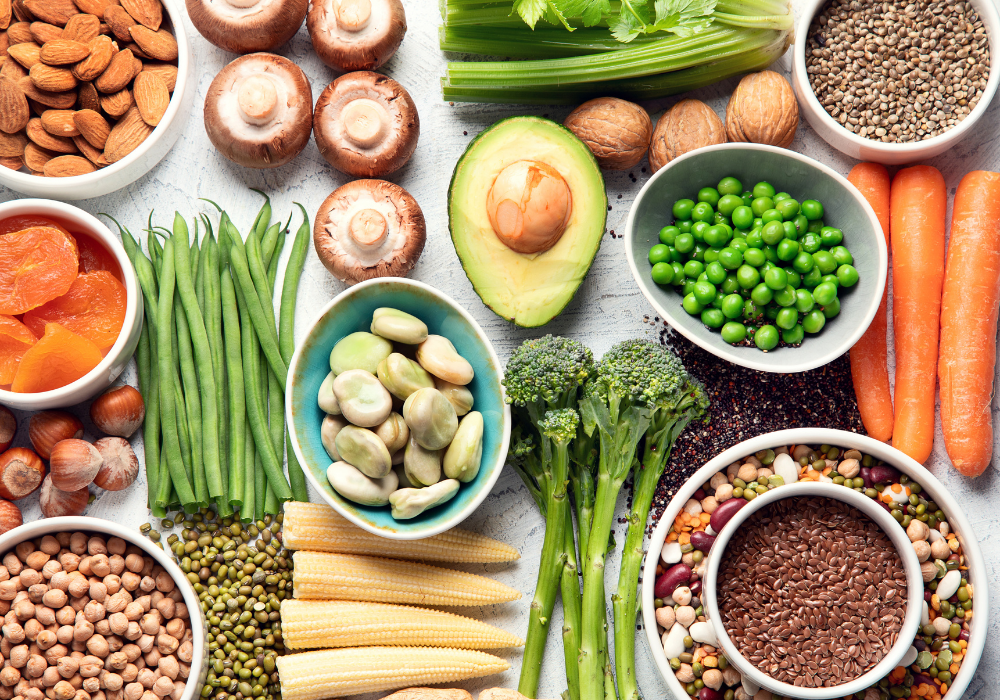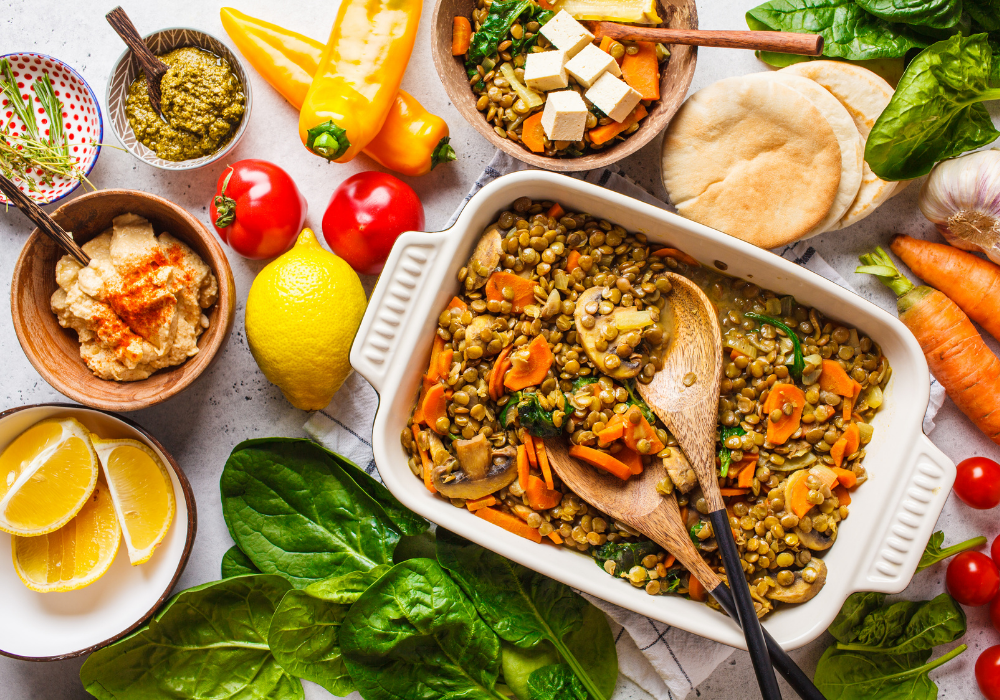Are you thriving on a plant-based diet? No? Not yet? Follow these ten steps and you soon will be!
The start of the year finds many people looking at their health and fitness and considering diet changes. If you’re in the same boat and are interested in transitioning to a plant-based diet, you might be overwhelmed with the overload of information available to you.
Should you throw out all the food in your fridge and dive in overnight? What exactly are you supposed to eat on a plant-based diet? Do you need to worry about protein like everyone seems to think?

So many questions! Luckily for you, this blog post contains answers to all your burning questions plus expert tips to make your transition stress-free.
Follow these ten steps in order and you’ll soon be thriving on a plant-based diet, without the overwhelm or stress!
STEP 1: Assess your current diet and lifestyle
The first thing you need to do to set your transition to a plant-based diet up for success is to figure out where you’re starting from. After all, if you don’t know where you are, how can you figure out where you want to go?
Then, once you have a clear idea of what your current diet looks like, you’ll be ready to move on to step two!
NUTRITIONIST’S TIP: Try keeping a food journal for a few days to help you accurately record what you eat. It will give you a better understanding of what your current diet looks like.
STEP 2: Get clear on your diet goals
Now that you know what your current diet looks like (it might be better or worse than you expected!), it’s time to get clear on where you want to go. Since you’re reading this, I’m going to go out on a limb and assume your goal is to transition to a plant-based diet. (I know, I’m a genius.)
Here’s the thing though, do you actually know what a plant-based diet is? You need to understand what your goal diet is about at its core before you can go about achieving those goals.
NUTRITIONIST’S TIP: There are different labels under the plant-based umbrella. The most common ones are plant-based, plant-predominant, and plant-exclusive. Explore these as a path to understanding the different ways a plant-based diet can look.
STEP 3: Build a plant-based kitchen
Now that you’re clear about where you’re starting from and where you want to end up, it’s time to take action on your goals.
Start by clearing space in your kitchen and pantry for plant-based foods. Depending on what your current diet looks like, this might be a big change or a small one. No matter what, don’t skip this step!
In order to change your habits, you must change your environment.
So go all in – reorganize your kitchen, your pantry, and your countertops.
Challenge yourself to get rid of animal products and replace them with plant-based alternatives.
NUTRITIONIST’S TIP: Don’t feel like you have to throw out all the animal products in your house to take action on this step. Instead, prioritize using up what you do have and then buy plant-based alternatives when you run out. Another option is to give your animal foods away to family, neighbors, or food pantries.
STEP 4: Master plant-based cooking basics
Time to get cookin’!
First, think about what you currently consider “a meal.” If you’re like most people in Western cultures, it probably includes a large piece of meat in the center of the plate. It may take some time and research but commit to unlearning how you used to think about and cook meals, and then reprogram yourself to cook in a plant-based kitchen. (Check out this blog post I wrote on changing the proportions on your plate to get you started!)
Now it’s time to find the key tools/equipment you need for your plant-based kitchen. As you start following plant-based recipes, compile a list of the tools that keep coming up that you don’t have. Then make a plan to acquire them. (Good news: if you already cook often, you’ll likely have all the kitchen tools you need!)
Another key part of learning to cook plant-based is getting comfortable using the culinary technique mise-en-place in your everyday cooking. Many plant-based dishes contain a long list of ingredients, so using mise-en-place to organize yourself will mean the difference between a confused, frantic experience, and an “I can do this!” experience. (Learn all about mise-en-place, what it is, and how you can easily adopt this technique into your own kitchen here.)
Lastly, develop strategies to ensure your cooking tastes delicious every time.
This might include any of the following:
- Cooking without a recipe
- Being able to make meals on the fly with what you have on hand
- Learning to properly follow a recipe
- Learning about the 6 different tastes (salty, sweet, spicy, bitter, sour, umami) and which foods fall into each category
CHEF’S TIP: try to include at least 3 different tastes in each dish for the best flavor!
Looking for a way to follow these 10 steps more easily? Download my Ten Step Roadmap to Thriving on a Plant-Based Diet! You can print out the roadmap and pin it up in your kitchen or near your desk to keep you on track.
STEP 5: Learn plant-based nutrition 101
To be successful following a plant-based diet long-term, you need to have a basic understanding of nutrition. Take some time to learn about basic plant-based nutrition (it’s way simpler than you think!) and you’ll save yourself from most of the challenges plant-based newbies face.
Your main focus should be on plant-based food groups.
When you focus on food groups, as opposed to nutrients, the macro and micronutrients generally take care of themselves.
Make a point of eating from all six whole-food plant-based food groups daily. These are:
- Fruits
- Vegetables
- Whole grains
- Legumes
- Nuts & seeds
- Herbs & spices
By doing just this one thing, no matter the nuances of your individual diet, you’ll already be far healthier than the majority of people!

STEP 6: Find plant-based swaps for everyday staples
As you get more comfortable with your new diet, spend some time testing out different plant-based swaps to find the ones you like. Don’t force-feed yourself almond milk if it makes you gag. In this day and age, there are so many plant-based alternatives for every possible animal product out there, you just have to try them out to find the ones that make your tastebuds sing.
In your search for tasty swaps, you’ll likely be introduced to many new-to-you foods that you have no idea how to cook with or eat. A few common ones are tofu, tempeh, nutritional yeast, and tahini, but there are countless others.
Don’t be discouraged by all these new foods! Treat this process like a game — look for recipes that feature these foods so you can learn how to properly cook with them, and don’t be discouraged if your first few attempts at making tofu or tempeh turn out inedible! I promise you that when cooked correctly, all these foods taste INCREDIBLE. There’s a learning curve to plant-based cooking; don’t give up. (If you’re looking for easy homemade swaps that you can make in your own kitchen, check out these 5 common swaps with recipes for how to make them.)
STEP 7: Address plant-based diet myths and concerns
Especially when you’re starting to change your diet, you won’t realize all the things you eat all the time that have animal products added in sneaky ways.
To solve this problem, learn how to read nutrition labels & ingredient lists, it’s not difficult! Get into the habit of doing this whenever you pick up a new product at the grocery store. This habit alone will save you from buying lots of foods that market themselves as “healthy” but don’t align with your diet goals.
Equally important, take special note of the five nutrients of focus on a plant-based diet to ensure you’re getting enough of them. The nutrients that deserve special attention are:
- Protein
- Calcium
- Iron
- Iodine
- Omega 3’s
NUTRITIONIST’S TIP: there are simple ways to get enough of these nutrients on a plant-based diet. The key is to be aware of them and develop the strategies needed to meet your daily requirements.
STEP 8: Nail down a supplement regime
No diet is perfect, and there are a few nutrients that everyone should be supplementing on a plant-based diet.
The one supplement I recommend to all my clients is a 500mcg B12 supplement (minimum) taken daily. I’m constantly surprised by the number of people following a plant-based diet who don’t supplement with B12. Don’t be one of those people! (You can learn all about the importance of including a B12 supplement in your diet here.)
In addition to B12, it’s a good idea for most people to supplement with vitamin D3 and possibly omega-3. (I recommend an algal oil capsule.) These two aren’t always necessary depending on your unique situation, but it’s a good idea to supplement if you don’t get enough sunlight every day and aren’t eating enough omega-3-rich nuts and seeds.
Lastly, selenium is an easy whole-food supplement that everyone should be consuming daily regardless of diet. Eat 1 Brazil nut per day and you’re golden!
STEP 9: Your daily nutrition targets
There are certain habits we can cultivate to make ourselves as disease-proof as possible. These habits are part of a strategy I like to call “health-proofing your diet.” This strategy is composed of the foods we eat, the supplements we take, and the lifestyle habits we participate in.
Foods to eat everyday
Remember in step 5 when you learned about the six plant-based food groups to eat every day? Don’t rely on your memory when you’re starting out! Develop an easy system to keep track of the food groups you consume daily that works for you.
(Here’s a simple yet effective idea: put up a whiteboard on your fridge with the 6 different food groups plus the ideal # of servings to eat per day, then check these off as you consume them daily.)
Supplements to take every day
I dove into this topic in the previous step, but just like with food groups, create a clear and easy-to-follow supplement regime for yourself. This could be as simple as taking your supplements at the same time every day with the same meal.
Lifestyle habits to cultivate
Aside from food and supplements, make it your goal to drink enough water (2-3 liters/day) and get outside in the sun every day.
These three areas combined will ensure you health-proof your diet and extend your years living a healthy, able-bodied life.
STEP 10: Organize and prepare
As the final step in your journey to thriving on a plant-based diet, do yourself a favor and embrace meal planning and preparation!
Eating a whole-food plant-based diet naturally involves more food prep and cooking (think: all the veggies you’re going to be chopping.)
The key to not getting overwhelmed as you transition your diet is to become a pro at meal planning and ingredient preparation!
I recommend creating a weekly meal plan for yourself that includes all your meals and snacks. Make a grocery list based on your plan, go grocery shopping and buy only what’s on that list, and then spend an hour or two once a week preparing ingredients for those upcoming meals so you have a head-start on cooking for the week. (Learn the detailed breakdown for this process here.)

Transitioning to a plant-based diet is overwhelming for a lot of people. You might have a hard time knowing where to start, figuring out what to eat, and understanding whether you’re doing plant-based in a healthy way or not – but it doesn’t have to be! Follow these ten steps and you’ll transition seamlessly from your current diet to a healthy plant-based diet that you can thrive on long-term!








